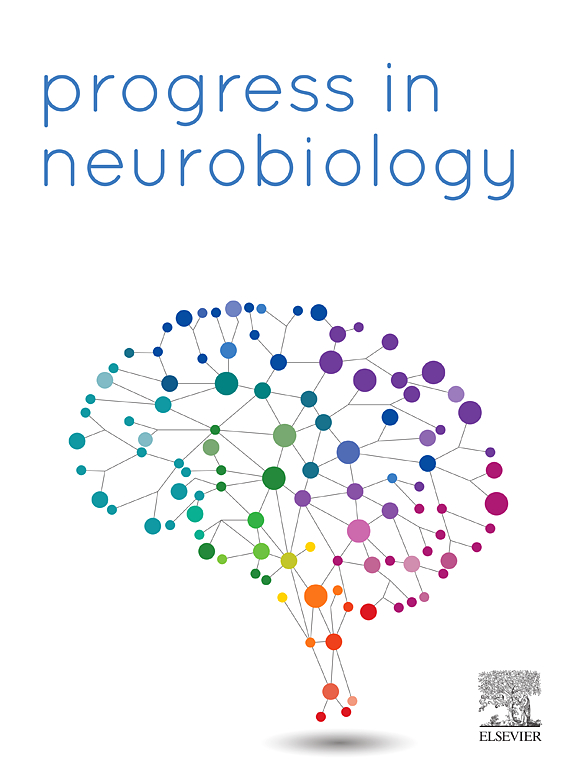bst投射的组胺能回路通过gaba能神经元上的突触后组胺H3受体介导状态依赖性焦虑行为
IF 6.1
2区 医学
Q1 NEUROSCIENCES
引用次数: 0
摘要
了解焦虑和焦虑障碍的确切机制对于确定新的干预措施至关重要。在这项研究中,我们报道了一个针对终纹床核(BNST)的组胺能回路,它介导了小鼠的焦虑样行为。首先,我们观察到当小鼠进入焦虑环境时,BNST的组胺信号和组胺能纤维活性均显著降低。bst -投射组胺能回路对状态依赖性焦虑行为的选择性调节:激活直接诱导幼稚小鼠产生焦虑效应,而抑制在焦虑状态而非正常状态小鼠中产生显著的焦虑解焦虑作用。药理干预表明,抑制组胺H3受体(H3Rs),而不是组胺H1受体(H1Rs)或组胺H2受体(H2Rs),在BNST中消除了组胺能回路激活的焦虑作用。最后,通过对空间特异性H3Rs的光遗传学操作,我们确定了BNST gaba能神经元突触后H3Rs对焦虑调节的关键作用,而不是来自上游输入的突触前H3Rs。总之,我们的研究结果揭示了一个针对BNST的组胺能回路,该回路通过突触后H3Rs介导状态依赖性焦虑样行为。这些发现为焦虑的机制提供了新的见解,并为发现治疗焦虑障碍的新药理学靶点提供了有希望的途径。本文章由计算机程序翻译,如有差异,请以英文原文为准。
BNST-projecting histaminergic circuits mediate state-dependent anxiety behavior through post-synaptic histamine H3 receptors on GABAergic neurons
Understanding the precise mechanisms underlying anxiety and anxiety disorders is crucial for identifying novel interventions. In this study, we report a histaminergic circuit targeting the bed nucleus of the stria terminalis (BNST) that mediates anxiety-like behavior in mice. First, we observed a significant decrease in both histamine signaling and histaminergic fiber activity in the BNST when mice entered an anxious environment. Selective modulation of the BNST-projecting histaminergic circuit mediated state-dependent anxiety behaviors: activation directly induced an anxiogenic effect on naive mice, while inhibition produced a significant anxiolytic effect in mice in an anxious state rather than normal state. Pharmacological intervention revealed that the inhibition of histamine H3 receptors (H3Rs), rather than histamine H1 receptors (H1Rs) or histamine H2 receptors (H2Rs), in the BNST abolished the anxiogenic effect of histaminergic circuit activation. Finally, through optogenetic manipulation of spatial-specific H3Rs, we identified a critical role for anxiety regulation by post-synaptic H3Rs in the BNST GABAergic neurons, rather than pre-synaptic H3Rs from upstream inputs. Together, our results revealed a histaminergic circuit targeting the BNST that mediates state-dependent anxiety-like behaviors through post-synaptic H3Rs. These findings provide new insights into the mechanism of anxiety and offer promising avenues for discovering novel pharmacological targets for the treatment of anxiety disorders.
求助全文
通过发布文献求助,成功后即可免费获取论文全文。
去求助
来源期刊

Progress in Neurobiology
医学-神经科学
CiteScore
12.80
自引率
1.50%
发文量
107
审稿时长
33 days
期刊介绍:
Progress in Neurobiology is an international journal that publishes groundbreaking original research, comprehensive review articles and opinion pieces written by leading researchers. The journal welcomes contributions from the broad field of neuroscience that apply neurophysiological, biochemical, pharmacological, molecular biological, anatomical, computational and behavioral analyses to problems of molecular, cellular, developmental, systems, and clinical neuroscience.
 求助内容:
求助内容: 应助结果提醒方式:
应助结果提醒方式:


